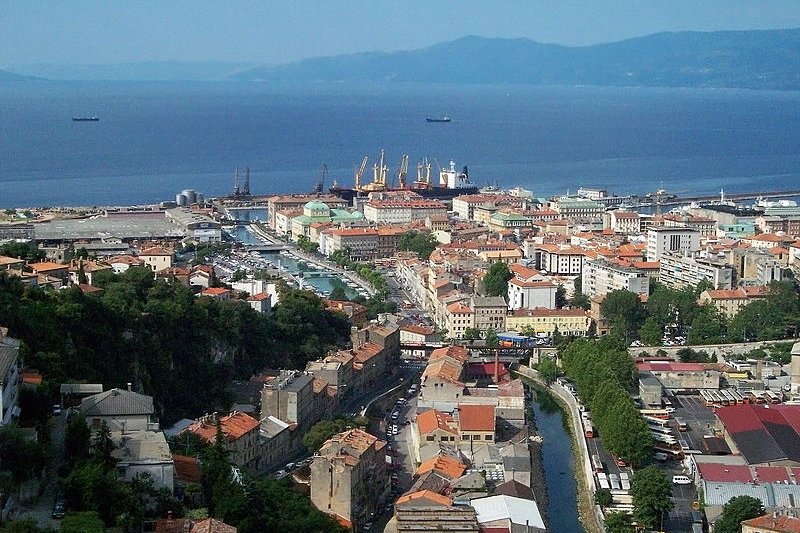 Rijeka, Croatia
Rijeka, CroatiaSource: https://commons.wikimedia.org/wiki/File:Rijeka-view-2.jpg
Author: László Szalai

Rijeka overlooks the Bay of Kvarner. To the north are the mountains of Gorski kotar while to the west the mountains of U&3269;ka. Offshore from Rijeka are the islands of Cres and Krk. Due to its location, Rijeka enjoys a pleasant Mediterranean climate (to be exact, a humid subtropical climate). It has sunny beaches and ski resorts less than 30 km from each other.
The warmest month in Rijeka is July, when the average high temperature touches 27.7°C (81.9°F). Coldest month is January, when the average low drops to 2.7°C (36.9°F). Rain is heaviest in November, at 183.4 mm (7.22 in).
 Church of the Capuchins in Rijeka
Church of the Capuchins in RijekaSource: https://commons.wikimedia.org/wiki/File:Crkva_Gospe_Lurdske_0704.jpg
Author: Roberta F

Evidence of human habitation in the Rijeka area goes back to Neolithic times. However the modern settlements in the area can be traced to a hillside village established by the Celts, and a coastal village established by a mariner tribe, the Liburni. This dual character of hillside and coast remains with Rijeka till today.
As with the many cities on the Adriatic coast, Rijeka was ruled by various powers through its long history. They included the Romans, the Ostrogoths, the Byzantines, the Lombards, the Avars, the Franks, the Croats, the Hungarians, the Venetians and particularly the Austrian Habburgs, under the Archduchy of Austria.
 Church of St Nicholas, Rijeka
Church of St Nicholas, RijekaSource: https://commons.wikimedia.org/wiki/File:Pravoslavna_crkva_sv_Nikole_040408.jpg
Author: Roberta F

The Austrians ruled Rijeka from 1466 until the collapse of the Austro-Hungarian Empire following World War I, except for a period during the Napoleonic war, from 1805 until 1813, when the French occupied and ruled the city. Rijeka was part of Italy from 1924 until 1943, when it was annexed by Germany. After the Second World War, Rijeka became part of Yugoslavia until it disintegrated in 1991, after which it became part of Croatia.
Visiting Rijeka
You can reach Rijeka by road, by rail and by air. There are flights to Rijeka from major cities in Croatia, as well as from Bonn/Cologne, Hannover, Stuttgart and Oslo. You can also take a train from Zagred, Osijek, Ljubljana and Budapest to Rijeka.Places of Interest in Rijeka
- Church of St Nicholas (Sv. Nikola)
Orthodox church built in 1790. It contains icons from Vojvodina, Serbia. - Cathedral of St Vitus (Katedrala Sv. Vida)
The cathedral dedicated to the patron saint of Rijeka was built by the Jesuits between 1638 and 1742 in the Baroque style. - Church of the Assumption (Crkva Uznesenja Blažene)
Originally built in the 13th century and renovated in the Baroque style in 1695, the church was also once a cathedral. Elements of Rococo was added in 1726. - Church of the Capuchins (Kapucinska crkva)
Church built in 1904-23 on the 50th anniversary of the miracle of Lourdes. - Civic Tower (Gradski Toranj)
Landmark tower in Rijeka dating to the 15th century, with alterations made in the 18th and 19th centuries. - Maritime and Historical Museum of Coastal Croatia (Pomorski i Povijesni Muzej Hrvatskog Primorja)
Founded in 1876, this is Rijeka's oldest museum. It recounts the city's history of navigation, exhibiting maritime artifacts from prehistory to the Middle Ages. - Roman Arch (Stara Vrata)
Remains of a Roman arch on the north side of the Rijeka main square. - Sanctuary of Our Lady of Trsat (Gospa Trsatska)
The Sanctuary of Our Lady of Trsat is a church and Francescan monastery complex built on a hill overlooking the Rječina River. It was built in 1452, though the site has been occupied by a church since the 12th century. - Town Hall (Municipij)
Once an Augustinian monastery in the 14th century, the public was turned into the Rijeka Town Hall in 1883. Today it houses the office of the University Rector. - Trsat Castle (Gradina Trsat)
Roman fortification erected to defend Tarsatica, located a short distance from the Sanctuary of Our Lady of Trsat.
 Latest updates on Penang Travel Tips
Latest updates on Penang Travel Tips
About this website

Thanks for reading this page. My name is Timothy Tye. My hobby is to research information about places, and share the information with people on this website. I started this website on 5 January 2003, and since then, have written about over 20,000 places, mostly in Malaysia and Singapore.
Please use the information on this page as guidance only. While I try my best to provide you information that is as accurate as I can get it to be, I do apologize for any errors. Also, as I might not be able to update some information on time, some of these pages may contain outdated information.
Copyright © 2003-2024 Timothy Tye. All Rights Reserved.


 Go Back
Go Back